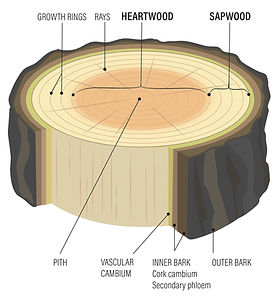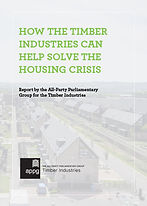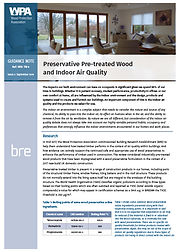 Christies CareAccoya® Wood building |  Timber CladdingPiveteau Bois timber clad house |
|---|
Building with wood
Sustainable, naturally strong, cost effective and tactile, what other building material can boast these credentials?
Sustainability and the environment
GO TO:
Wood is commonly recognised as sustainable by virtue of it being a renewable resource.
In addition to the provision of timber, forests represent some of the richest biological areas on Earth, providing food and livelihoods for millions of people and habitats for wildlife.
Through the work of organisations such as the Programme for the Endorsement of Forest Certification PEFC and The Forest Stewardship Council FSC, modern forestry standards ensure wood is harvested and procured in a responsible, sustainable way, with new trees being planted to replenish stock.
As they grow, trees absorb CO2. By building with timber, carbon from the atmosphere is being stored in the built environment. So it follows that using wood stimulates the expansion of managed forests and reduces the levels of global warming gas. Why wouldn’t we encourage the use of wood?
The WPA are ardent supporters of Wood for Good and their Wood CO2ts less campaign - for more information visit here.
Wood CO2ts less is a collective mark of Wood for Good Ltd. Using wood from sustainably-managed forests instead of other materials is a good way to reduce CO2 emissions.

Net-zero carbon targets
The environmental impact of building decisions, including material selection, is of increasing importance to both specifiers and builders alike. Compared with alternative building materials of similar durability, such as concrete or steel, the cost and energy input of pre-treated wood production is comparatively low. There is an increasing amount of research driven evidence to support this.

Wood - Building the Bio-economy
Published by the European Confederation of Woodworking Industries (CEI-Bois) this book sets out the environmental arguments for using wood over alternative building materials at the same time as putting the industry’s economic contribution in context. Backed by contextual, factual research it illustrates how wood, being used, re-used and recycled, is a model product for Europe's transition towards a circular economy.

Sustainability and Timber Treatments
Does wood’s performance need to be ‘artificially enhanced’ with a timber treatment is a common question. In many situations it doesn't. Wood has many enduring properties which lend themselves to the environments in which they are used.
Softwoods such as Cedar, Pine and Spruce, are fast growing and are therefore used more frequently because of availability and furthermore, affordability. However, softwoods are generally not as durable as slow growing more expensive hardwoods and this is why timber treatments are applied - to extend their durability. This in turn, reduces pressure on the more naturally durable, scarcer and higher value species.
Pre-treatment allows the use of the more perishable (sapwood) and non-durable parts of a tree where they might otherwise be discarded or have a short service life. This makes the most of the timber resource and contributes to waste minimisation.

Chemicals and us
But what about the 'chemical' aspect of treatment? Our lives are full of materials which have ‘chemical additives’ if we were to eliminate their use altogether, our lives would be very different – and not necessarily for the better. The industry continues to introduce products which are better targeted towards the organisms we wish to control and are less hazardous to the wider environment. This trend will continue. By assessing the benefits gained against the negative impacts then the justification for timber treatments can be appreciated.
This executive summary of a report by the trade bodies representing and working in the European pressure treated wood industry (WEI and EWPM), examines the sustainability of treated timber and the balance of social, economic and environmental aspects.
Wood Campus have many on-line resources covering amongst other topics, timber sourcing, procurement and the benefits of building with wood.

Building Better
.jpeg)
As the world becomes increasingly aware of human impact on the planet, there’s a greater demand for efficient, healthier and more versatile building solutions. Design trends are changing to meet these demands and wood has a starring role.
Cost Effective and Versatile
Along with its low environmental impact attributes, strength and ease of working, wood can deliver economic advantages to projects of all sizes and in many ways:
-
Lends itself to offsite construction methods speeding up average build times.
-
Engineered timber technologies such as Glulam and cross-laminated timber (CLT) expand structural capabilities, producing large scale building components especially used in taller buildings.
-
High strength to weight ratio – wood is much lighter by volume than both concrete and steel, it is easy to work with and very adaptable on site
-
Natural mechanical properties and low coefficient of expansion give it residual strength - it will not buckle or collapse as easily as steel in a fire.
-
Low carbon footprint – requires less energy to produce than other construction materials.


Wood - solving the housing crisis and much more
An inquiry by the All Party Parliamentary Group for the Timber Industries (2019) examined the role that timber could play in a changing world – by providing skilled jobs, delivering sustainable and affordable homes and being at the forefront of addressing climate change. The report contains many positive arguments in favour of wood backed by comprehensive research findings. Real world case studies provide inspiration and recommendations of best practice.
Solutions to insurance challenges around building tall with wood
RISC Authority is a research scheme supported by a significant group of UK insurers and is part of the Fire Protection Association. As part of their work to support timber businesses, RISC has reviewed the insurance challenges faced by multi-storey commercial and residential timber projects. Where the provision of affordable insurance might be a problem, the report suggests potential solutions that satisfy both the client’s carbon reduction ambitions and the insurance risk control needs. In doing so RISC Authority clearly recognise the ever-increasing demand for low carbon timber building solutions.
The Passive House Movement
Becoming increasingly popular, the principles of this movement are concerned with efficient design and construction techniques. Passive buildings manage their interior climate with less or no energy, resulting in reduced carbon footprints, using as much as 90 percent less energy than typical buildings. Wood can help realise such passive design principles because of its natural thermal insulating properties, water resistance and structural integrity. See passivhaustrust.org.uk
Health & Wellbeing
We spend a lot of time indoors so the impact our buildings have on how we feel, work, learn and relax is an increasingly researched subject. Wood has a natural warmth whilst reminding us of the great outdoors. Wood is a healthy building material and preservative treated timber has been proven to have insignificant effects on indoor air quality.
tell me more


Biophillic Design
The premise behind biophilic design is the idea that incorporating natural elements in the built environment, such as wood, water, sunlight or plants, can actually improve overall health.
In healthcare, care home and office environments, designers are embracing biophilic design, rediscovering the aesthetics of wood to improve patient experiences and staff performance. BRE group are carrying out extensive research - read more here www.bregroup.com

Handling and storing preservative treated timber
Wood preservatives used in industrial treatment plants are highly regulated to ensure they are safe and effective. Equally, suppliers and end users have a duty of care to store, handle and use treated timber as advised by the supplier of the treated wood product.
Re-use, recycle and disposal
Preservative pre-treatment extends the service life of wood for many years. At the end of its service life treated wood can be re-used or recycled for approved applications or disposed of in a way that minimises any potential for environmental damage.
The WPA, in collaboration with the Wood Recyclers Association, has published Guidance Note TW 14 to help ensure that waste wood is: correctly classified at its origin; is not mis-described and is processed into appropriate end uses; can be identified as hazardous or not.
Most modified woods can be handled as any other untreated wood waste. They do not contain any toxins or heavy metals that can harm the environment and can be disposed of at the end of their service life by either burning or placing into the normal waste system or be re-used or recycled for approved applications. See the wood modification section which has direct links to product manufacturers for more information.
Wood in action
Wood has long been used as a structural and finishing material in construction, just look at the iconic buildings still around today. The appeal for wood across building segments comes from its unique aesthetic qualities, natural durability, flexibility, installation efficiency and ease of use. Coupled with timber protection technologies and advanced engineering practices, wood can add to environmental cost savings, building performance and speed to market. Take a look at some of our member’s inspirational projects in the Gallery.

















